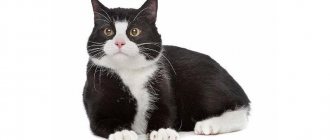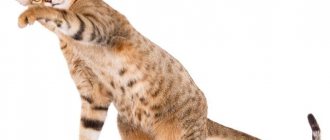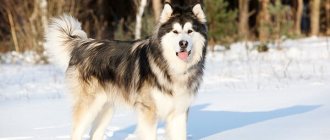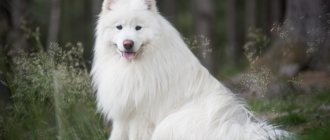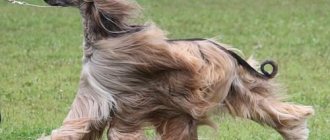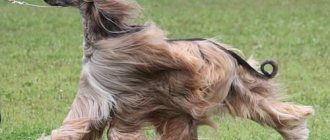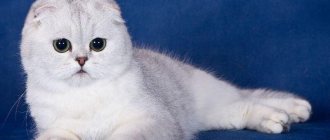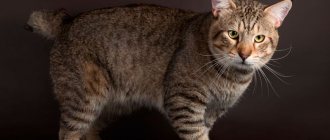The history of munchkins
Munchkins are charming short-legged cats.
In the 30s of the twentieth century, references to unusual short-legged cats periodically appeared in Europe. The Second World War, which soon broke out, almost completely erased this genetic line. In 1944, one of the British veterinarians reported observations of several generations of cats that were similar to ordinary domestic cats except for the parameters of the limbs. After the war, such animals were seen in the USA and USSR. In 1953, Soviet sources dubbed them "Stalingrad kangaroos", suggesting that the mutation occurred due to existence in harsh conditions.
The modern round of development of the Munchkin breed occurred in 1983, when teacher Sandra Hochenedel from Louisiana, returning home, noticed an unusual pregnant cat. The woman took pity on her and took her in, giving her the nickname Blackberry. Half of the kittens that were born also had short legs, which surprised Sandra. She decided to give an unusual pet to her friend Kay LaFrance. This is how the Blackbury and Toulouse cats became the ancestors of the modern breed.
Sandra and Kay managed to interest Dr. Solveig Pflueger, who served as a TICA judge, about munchkins. He examined the unusual cats and made an unequivocal verdict - the breed appeared naturally, thanks to changes in the recessive gene that regulates the length of the paws. Unlike dachshunds and other short animals, munchkins' short legs usually do not lead to back problems.
Munchkin kitten
The general public first learned about the breed at the TICA national show held at Madison Square Garden in 1991. Most viewers and experts were critical of the viability of munchkins, branding them living evidence of violations of the breeders' ethics. Despite lengthy disputes, by 1994 TICA managed to list the breed as developing. In the early 2000s, munchkins won the championship title and gained real popularity.
The breed is recognized by the associations TICA, AACE, UFO, SACC and WNCA. The FIF, CFA and Governing Council of the Cat Fancy societies refused to register munchkins, considering these cats to be genetically inferior. TICA resolved the issue democratically - only cats whose owners are able to confirm a monobreed pedigree in three or more generations are allowed to participate in the show. Munchkins got their unusual name in honor of the cheerful, friendly people from the book “The Wonderful Wizard of Oz.”
Skookum
These felines have long, wavy hair and short legs. The breed emerged as a result of crossing laperm cats with munchkins. Males of this breed weigh up to 4 kg, females - up to 3.5 kg. Interestingly, the charming pets of this breed have longer front legs than their hind legs.
Skookum is a breed of curly-haired, short-haired cat.
Skookums have inherited the munchkin's personality. They are incredibly inquisitive and active. Kids can spend hours playing with everything that rolls and rustles. Skookums are very friendly towards all family members, without focusing on one owner. Due to their friendly nature, pets get along well with small children and animals. Skookums are silent cats; they practically never meow.
There are no special nutritional requirements for animals of this breed. However, the breeder will be able to answer all your questions regarding the recommended diet in detail.
Cats are unpretentious, so they do not require special care. Particularly careful care of wool is needed before exhibitions. It is washed with shampoo and wiped dry. For extra splendor, spray with water.
If the pet is kept in normal conditions and eats well, it will not have any special health problems. When breeding, there is one nuance - you cannot cross cats of this breed with representatives of other breeds, otherwise there is a risk of kittens being born with deformed paws.
Skookums are an expensive breed, as they are rare, developing and even experimental. It is difficult to buy a kitten of this breed not only in Russia, but also in the world. They are sold in nurseries in Europe and the USA. The price is high - from 800 to 3500 euros. Therefore, if you decide to get such a kitten, get ready for serious expenses.
Munchkin appearance
Munchkin
Munchkins are unique and cannot be confused with other cats due to their greatly shortened paws. With an average body size, the legs of these cats are 2-3 times smaller than those of other breeds. Despite this mutation, munchkins have retained a healthy spine, so they have a mobile, flexible, strong body. The average weight of cats ranges from 2.2 to 4 kilograms.
Munchkins are often crossed with other breeds, so they can differ in appearance and personality. The offspring are often long-legged. Such cats do not participate in shows, but can be used for the development of the breed, since the presence of two short-legged parents increases the mortality rate of kittens in the litter. Breeders are actively developing munchkins, so associations have not yet introduced strict standards.
Head
Proportional to the size of the body, has rounded contours, the shape of a modified wedge. The cheekbones are high and are usually more pronounced in cats than in cats. The muzzle is of medium length, the transition of the nose to the forehead is smooth. Some deflection of the bridge of the nose is allowed. The chin is small and firm.
Eyes
Munchkin looks out the window
Almond-shaped, medium to large in size. The rather wide set at a slight angle provides an open expression to the muzzle. Munchkins do not have a strict connection between eye color and coat color.
Ears
The ears are wide at the base and rounded at the tips. Sinks can be medium or large in size, located wide and high. The presence of tassels is permissible only in representatives of the breed with long hair.
Neck
Cats have larger, more muscular, dense necks than cats.
Body
The Munchkin's body is elongated and cannot be called compact. The back has a slight downward slope from the tail to the shoulders. The hips are firm, the chest is rounded. The bones are of medium size, the muscles are well developed. Males are usually larger than cats. Angled blades are allowed.
Munchkin and his toys
Legs
The limbs are short, located at the same distance in the direction of view from head to tail. The upper and lower parts of the front legs, as well as the thighs and lower parts of the hind legs, are equal in length. The hind limbs are often slightly longer than the forelimbs. Munchkins have three legs: regular, short, and very short (Rug hugger).
Paws
Red munchkin kitten
The Munchkin's paws are proportional to the body and have a rounded shape. Curvature outward or inward is not allowed.
Tail
The length of the tail and body is usually the same. The thickness is average, there is a rounded, somewhat narrowed tip. During movement, the tail comes to a vertical position. If there is long hair, this part of the body receives an abundant plume.
Wool
The coat is silky semi-long or velvety short, with medium undercoat.
Colors
Munchkins can have any coat color; bicolored individuals are often found.
Lifespan
Munchkins live 12-13 years, but with professional care they can live up to 16-20 years.
Possible disadvantages
Too short or long nose, protruding chest bone, round head and eyes, cow-type paws, stocky short body, curly hair.
Disqualification criteria
Deafness, amputated claws, cryptorchidism.
Disqualifying defects for exhibition
The presence of characteristic features of other breeds, saggy croup, excessively concave back.
Breeds of short-legged cats
Having achieved public recognition of short-legged cats, breeders did not stop there. They continue to experiment, creating new breeds of miniature pets.
Table: physiological characteristics characteristic of representatives of short-legged breeds
| Options | Dimensions |
| Height at withers | 15–25 cm |
| Leg length | 1/3 of the height at the withers |
| Weight |
|
Munchkin
Munchkins are the ancestors of all short-legged cat breeds. These pets are called “dachshund cats.” The similarity is due to physiological characteristics - miniature stature, elongated body and short legs.
Curious little munchkins love to control everything that happens around them. To do this, they stretch out in a column, taking a meerkat pose. Cats can stay in this position for hours, looking out the window or watching the household.
Munchkins are actively used in breeding as carriers of the gene for short legs
These big-eyed and cute “buttons,” despite their short limbs, are very active and mobile animals. They have a calm and balanced character. Cats are quite social and easily make contact with all family members and animals living in the same territory. Little ones love affection and willingly give mutual love and tenderness to their owner.
Photo gallery: Munchkin cats
Munchkin Liliput is listed in the Guinness Book of World Records as the shortest animal in the world
Munchkin kittens are very similar to a small plush toy
Curious munchkins can stand on their hind legs for hours in the meerkat pose.
Video: Munchkin cat
Minskin
The Minskin is a cross between the Munchkin and the Canadian Sphynx. Later, two more breeds were added to breeding - the Devon Rex and the Burmese. Minskins have fur on the tips of their paws and ears, which is why they are nicknamed hobbits.
Minskins are very miniature animals, weighing no more than 3 kg
Pets have a calm and friendly character. They are very sociable and easily get close to all household members and animals living in the neighborhood. Minskins are very attached to one owner and literally follow on his heels. They get very sad when they are apart, so they should not be left alone for a long time.
Photo gallery: Minskin cats
Minskin cats have a delicate skin that feels like cashmere.
Kittens have a very mischievous and spontaneous character, but with age they become more sedate
The furry points growing on the tips of the paws and ears gave munchkins their second name - hobbits.
Video: Minskin - all about the breed
Bambino
Bambino cats are a cross between a Munchkin and a Sphynx, just like the Minskin, so these breeds are often confused and the Minskin is sometimes considered a variant of the Bambino. Minskins are distinguished by the presence of hair on the head, ears, paws and tail. Representatives of the bambino breed are carriers of two special genes at once - short legs and hairlessness. The name "bambino" is translated from Italian as "child". And this is true - amazing animals remain children even in old age.
Bambinos love to sit on their hind legs, stretched out like a kangaroo.
Cute little ones have a sociable character and easily join any team. They get along well with all family members, but for themselves they choose a leader to whom they remain devoted until the end of their lives. Absolutely non-aggressive bambinos get along well with all pets living in the neighborhood. Cats make excellent companions for people who are willing to devote enough time to them.
Photo gallery: Bambino cats
The velor skin of a bambino can be of any color, but solid colors are most valued.
The ears of bambino cats are decorated with small tassels.
The graceful bambino looks like an ivory figurine
Video: Bambino cat breed
Napoleon (minuet)
The Napoleon breed was created by crossing munchkins with long-haired Persians. At first the cat was named in honor of the great commander Napoleon Bonaparte, but in 2015 the breed was given another name - Minuet. Cute babies inherited their miniature size from the Munchkins, and from the Persians - a luxurious fur coat with thick pile, large round eyes and a slightly flattened muzzle.
Napoleon owners claim that pets not only help relieve stress, but can also relieve pain
Napoleons are very gentle and affectionate pets, ready to stay with their owner all day long. Their sociability and friendliness have no boundaries. Cats are extremely attached to one owner, but treat all family members with respect. These cats absolutely do not know how to show aggression, so the breed is ideal for families with small children.
Photo gallery: Napoleon cat
Long-haired specimens of the Persian type require more frequent combing and removal of tangles. The hair of Napoleons can be long and silky, or it can be short and plush, like exotics.
The Napoleon kitten is incredibly attached to people and is in dire need of constant love and care.
Video: Napoleon cat
Dwelf
The closest relatives of Dwelfs are Canadian Sphynxes, Munchkins and American Curls. As a result of selection, offspring were obtained with short legs, a hairless body and ears bent back.
Dwelfs inherited from their relatives their miniature size, hairless body and backward-curved ears.
Despite their unusual appearance, Dwelfs are no different from their relatives. These cats are inquisitive, smart and affectionate. They choose one owner and sincerely become attached to him. Dwelfs get along well not only with all family members, but also with animals. Small pets are very vulnerable and touchy, so you need to communicate with them very carefully.
Photo gallery: Dwelf cats
Dwelf kittens have small folds on their bodies that disappear with age.
The weight of an adult Dwelf practically does not exceed 2 kg
Dwelfs have an exotic appearance
Video: Dwelf breed
Kinkaloe
The Kinkalow is a cross between the Munchkin and the American Curl. This is a young and rare breed, which numbers no more than a dozen specimens.
Kinkaloos are born with straight ears, which bend 90-180° a couple of weeks after birth.
Kinkalow wool has an extraordinary shine and silkiness.
Pets are distinguished not only by their special appearance, but also by their balanced character. Cats easily fit into any group, love social games and are quite peaceful with other animals. They choose one owner, whom they sincerely love and yearn for separation from him. Kinkalows are ideal companions that rightfully become favorites of the whole family.
Photo gallery: Kinkalow cats
Kittens' ears begin to curl two weeks after birth and are fully formed by 5 months.
Kinkalow cats can be of any color, and the color of their eyes directly depends on the color of their coat. Kinkalows inherited the signature meerkat pose from the Munchkin.
Video: miniature kinkalow cats
Skookum
The Skookum breed was created by crossing the Short-legged Munchkin and the Curly-haired La Perma. Translated from the Indian dialect, “skukum” means “brave”, “unbending”.
Pets can be short-haired or long-haired, and the longer the hair, the more curly it is.
Skookum cats inherited short limbs from Munchkins and curly hair from La Perms.
Skookums have inherited the munchkin's personality. They are incredibly inquisitive and active. Kids can spend hours playing with everything that rolls and rustles. Skookums are very friendly towards all family members, without focusing on one owner. Due to their friendly nature, pets get along well with small children and animals. Skookums are silent cats; they practically never meow.
Photo gallery: Skookum cats
Kittens are sometimes born with different colored eyes
The shorter the skookum's fur, the less curl it has.
The Skookum breed is one of the experimental ones, so purchasing kittens is quite difficult and expensive.
Video: Skookum cats
Lambkin
Lambkins (translated from English as lambs) were the result of mating a Muncchin and a Selkirk Rex. Cats look like miniature, short-legged sheep. Features of lambkins are unusual sapphire-colored eyes, strong, short limbs and curly fur. There are so few representatives of this breed that they can literally be counted on one hand.
The Lambkin breed is distinguished by short, dense limbs, curly hair and sky blue eyes.
Lambkins are very inquisitive, cheerful and restless animals. These pets love all family members without exception, but are especially attached to children. Cats are never bored and can keep themselves busy in the absence of their owners. Lambkins are loyal to all animals.
Gallery: lambkin cats
Lambkin cats look like miniature, short-legged sheep.
The lambkin's mischievous face is decorated with curly vibrissae
The little lambkin's curls resemble a perm
Video: lambkin breed
Photos of munchkins
What to look for when choosing a kitten
Sometimes cute babies with short legs are offered for sale second-hand in various Viber groups or social networks. You can immediately fall in love with the purr from the photo, but you shouldn’t rush to pay for a real purchase. Before purchasing a pet, you need to observe it in reality, paying attention to the following points:
- The baby must be at least 3 months old. A very small kitten separated from its mother may die;
- Healthy babies are quite active. They are active, playful and cocky. If the baby is passive and does not want to run, he may have health problems;
- The baby's legs should be even and the fur should be smooth. It is important that the eyes are clean and free of discharge;
- A shy kitten that is afraid to approach a person is not the most suitable pet. A child who shows aggression is also not the best option;
- In the litter, a mother with short legs may have babies with long legs. They have the same pedigree as their shorter brothers and sisters and may in the future become the parents of offspring with a standard build for the breed. If you like such a baby, you shouldn’t refuse him.
When buying a kitten, you should ask the breeder about the parents, their habits and pedigree. It is also worth asking the owner for documents for the animal. It is advisable that by the time of purchase the baby is accustomed to the tray.
Cats with short legs can become true friends and true members of your family. All the breeds listed above are distinguished by their kind nature, curiosity and playfulness. Just look at these adorable kittens - how can you not fall in love with them at first sight?
Munchkin character
Munchkin on his hind legs
Munchkin looks at life realistically and does not complain about its trials, is confident in himself and his abilities, good-natured, and curious. People see these cats as slightly out of this world. It cannot be said that the character of munchkins is approximately the same, it depends on genes, so their types of behavior are different. But in general, these are lively animals with great sympathy for people.
Representatives of the breed love outdoor games; the short legs of munchkins do not prevent them from being quite nimble: they very quickly jump on low tables, chairs, and other furniture. And the owners’ favorite curtains are also easily attacked by them. Of course, they won’t be able to jump too high, but stealing something tasty from the kitchen table after first jumping on, for example, a stool is a piece of cake for them.
Munchkins are smart, very friendly, clean animals that quickly get used to new surroundings and people. They remain playful throughout their lives and are especially fond of children. Munchkins are extremely inquisitive, often “borrowing” and hiding small things to play with in moments of loneliness, so it is better to hide all valuable, fragile trinkets away. It is advisable to periodically look for such “treasuries”, since missing keys, socks, and pencils are usually found there.
Munchkins are distinguished by truly canine devotion to their owner, but they have their own character and are able to stand up for themselves. These cats easily tolerate travel and do not resist walks on a harness. An interesting feature of the breed is the ability to sit on its hind legs for a long time, surveying the surroundings. At the same time, the front legs hang funny along the body, which is why munchkins are often called “kangaroo cats.”
Advantages and disadvantages
The breed has many more positive aspects than negative aspects:
| Advantages | Flaws |
| Obedient, good-natured, smart. | They have a habit of hiding things. |
| They calmly accept changes and new surroundings. | They don't catch rodents. |
| They rarely get sick. | You should not be allowed out for walks unattended. |
| They don’t jump on tables or cabinets, so they don’t hit fragile things or steal food. | If you don't hide the toys, they wake you up at night. |
| Do not require special care. | |
| Not picky eaters. | |
| Do not spoil indoor flowers. | |
| They are good with children and other pets. | |
| Not intrusive. | |
| Not aggressive. | |
| They rarely meow. |
Care and maintenance
Who is the most curious cat?
This breed is easy to maintain and does not require special care. Experts recommend following a few simple rules.
- Despite the sociable nature of cats, they love to “build nests” in order to feel protected while resting. Provide the munchkin with a basket, small sturdy box, or other house with soft bedding.
- Buy a deep tray, since clean pets actively bury waste and can litter around.
- It is enough to comb short-haired munchkins once a week, and 2 times a week for long-haired munchkins. The main thing is to prevent tangles from occurring.
- It is enough to bathe these cats once every 3-4 months with special shampoos.
- Changing claws is usually easy for munchkins, especially if there is a scratching post in the house. Once every 2-3 weeks it is worth checking the condition of the paws in order to help the pet if necessary.
- You should clean your ears not deeply and very carefully, about once a month.
- It is not advisable to let cats go for walks on their own, as a squat animal often looks like it is preparing to attack, which may be misunderstood by other pets or people. Due to the short legs, the munchkin can be injured.
- Munchkins should be fed in moderation because, despite their high mobility, they are prone to obesity. Provide frequent replacement of drinking water and adequate nutrition.
- By using special toothpastes once a month, you can successfully prevent the development of oral diseases in munchkins.
Om-Nom-nom
As for food, it is not recommended to feed your cat from a common table. Use specialized or separately prepared natural foods. These types of food should be alternated, but not mixed in one plate. Do not buy cheap food as it is similar to fast food for humans. Are you planning to cook food for your munchkin at home? Experts advise preparing your diet this way:
- 60% – raw or boiled meat (rabbit, beef, offal);
- 30% – boiled or raw vegetables;
- 10% – porridge.
Munchkins should not be treated to salty, sweet, fried, smoked, bean dishes, fish, or fatty meats (lamb, pork). An adult cat can be fed a couple of times a day, kittens - up to 6 times a day.
Nutrition
The number of meals depends on the age of the pet:
- up to four weeks - five times a day;
- from twelve weeks to one year - three or four times;
- adults - twice.
Up to four months it is necessary to give porridge, meat, and fermented milk products. The diet of adults includes vegetables and fish fillets.
Premium dry and wet food and holistic foods are recommended.
Required products on the menu:
- unsweetened fermented milk products without dyes and synthetic thickeners;
- dietary meat;
- sea fish;
- cereals, excluding legumes;
- vegetables, except potatoes;
- chicken and quail yolks;
- meat by-products (for example, liver).
Fish and meat should be boiled and mixed into porridge. Vegetables are not fully digestible by animals. This must be taken into account when creating a menu.
Munchkin health
Two Friends
The Munchkin is a young breed with an actively expanding gene pool, so its representatives rarely suffer from congenital diseases and have good immunity. Owners should know that such cats have some intolerance to plant foods, so their share in the diet should be small. Sometimes there are cases of congenital lordosis - excessive deflection of the spine in the area of the shoulder blades.
Munchkins may suffer from lordosis. This is a disease in which the muscles that support the spinal column are weakened and it moves into the chest cavity, putting pressure on the heart and lungs. A slight curvature will not cause problems, but it can be aggravated by previous injuries and obesity. Severe lordosis causes difficulty breathing and increases stress on the heart muscle, which can lead to illness. However, lordosis is a fairly rare disease. By the way, other cat breeds can also suffer from it.
Since the munchkin's short paws are a consequence of a natural genetic mutation, some kittens may have short paws, while others may have normal or long paws. If the gene responsible for short limbs is passed on to an embryo from both parents, it can be fatal.
Dwelf
The closest relatives of Dwelfs are Canadian Sphynxes, Munchkins and American Curls. As a result of selection, offspring were obtained with short legs, a hairless body and ears bent back.
Dwelf is a breed of hairless, short-legged cats with folded back ears.
Despite their unusual appearance, Dwelfs are no different from their relatives. These cats are inquisitive, smart and affectionate. They choose one owner and sincerely become attached to him. Dwelfs get along well not only with all family members, but also with animals. Small pets are very vulnerable and touchy, so you need to communicate with them very carefully.
The breed is very rare and is not recognized by all feline associations, since it has not yet been determined how such a number of mutations will affect the health of cats.
How to choose a kitten
The rules for selecting munchkin kittens are standard: take active, clean babies aged 12 weeks or older with the necessary vaccinations. Contact only reputable kennels that offer registered animals. This will allow you to purchase a truly healthy kitten, without serious congenital defects. Munchkins have won the love of a wide audience, so real queues often line up for them. If you don’t care about a certain gender, color type, or coat length, you can get a kitten fairly quickly. You should not buy munchkins at bird markets or through private advertisements, tempted by the low price. This can result in long-term treatment of the animal or the acquisition of a non-viable individual.
Features of caring for short-legged cats
Representatives of short-legged breeds need regular brushing; hairless cats require daily bathing. Ear cleaning and eye rinsing procedures are required.
Cats do not like water, but hairless breeds should be taught to use water. Sweat and dust accumulate on the animal's body and must be removed. These cats can get sunburned or freeze in cold temperatures. It is important to monitor your pet's exposure to air.
Short-legged cats do not need walking, but they will happily walk on fresh grass. Cats are not good at climbing and jumping, so it is recommended to ensure that your family pet does not fall and get injured.
Photos of munchkin kittens
Cat sizes and weights
The Munchkin cat with short legs is not large in size. Body length is average. The height of the animals' withers is approximately 15 cm. Kittens quickly increase in size.
Weight depends on gender. The weight of a cat is 3-4 kg, a female cat is 2-4 kg. The size of munchkins also depends on the species. There are cats that are larger than the standard parameters, and there are cats that are smaller.
A Munchkin cat with short legs is not large in size/Yandex Collections
How much does a munchkin cost?
The price of a Munchkin kitten in Russia ranges from 3 to 40 thousand rubles, depending on gender, color, coat length, and the specific breeder. It is customary to cross Munchkins only with healthy domestic cats of similar appearance or with each other. Hybrid kittens that have inherited characteristics of other breeds are not allowed to show and are therefore sold at a reduced price. They do not differ in character from their counterparts and sometimes look nicer than the show ones. Also, healthy pets with other appearance features that cause disqualification from competitions will cost less. This is a great opportunity to acquire a loyal four-legged friend inexpensively.
Kinkaloe
The combination of the Munchkin and the American Curl gave rise to a new species - the Kinkalow. This is a fairly new breed, so there are not many similar understated cats.
Kinkaloo is a breed of short-legged cats with curled ears.
A distinctive feature of the kinkalow is the ears - immediately after birth they are straight, and after a couple of weeks they begin to bend, gradually forming an angle from 90 to 180 degrees. Full formation occurs by 5 months.
Six fold-eared pets of this breed are fluffy and shiny. The weight is small - up to 3 kg.
Cats have a calm character, love to play, and accept other pets normally. Cats immediately choose their only owner, whom they love very much and are sad without him. They treat other family members friendly and do not show aggression. Additionally, Kinkaloos are known for their quirks: they love trampolines and often sleep on their backs.
The price is high due to the fact that the breed is rare - from 500 to 1000 euros. You can only buy it in the USA.
Minskin
https://www.instagram.com/p/BqGlG5Qnurj/?utm_source=ig_web_copy_link
As already mentioned, munchkins differ from ordinary mongrel cats only in the length of their legs. Their “simple” appearance suggested and continues to prompt breeders to think about creating a short-legged breed with a unique appearance. No one knows exactly how many breeders came up with such an idea, but the second person who managed to achieve some success was P. McSorley. In 1998, he began work on developing a new breed based on Munchkins and Canadian Sphynxes, and soon “involved” the Devon Rex and Burmese in the breeding.
A few years later, TICA included Minskins in the list of experimental breeds, but today they still have not recognized them, just as other felinological systems of the world have not recognized them. The breed standard is still being formed; its distinctive features are a compact, strong body, a rounded head with large, seemingly alert ears. The coat of Minskins is a different story. Fairly short hair covers the paws, muzzle, ears and tail. There is much less hair on the body, and the belly should be bare.
Napoleon (minuet)
https://www.instagram.com/p/BsA2XIglIKn/?utm_source=ig_web_copy_link
This is a miniature cat with strong bones, a funny flattened face, thick fur and a soft, friendly character. Napoleon's ancestors include Persians and exotics, so the standard allows for any coat length and almost any color. The “Napoleonic invasion” began with an inconspicuous incident: in 1995, basset hound breeder D. Smith read an article in the newspaper about munchkins. And I was very happy that the “short-legged” cat gene had finally been found. He found out that the munchkin differs from an ordinary mongrel cat only in the length of its legs, and does not yet have its own “face”.
Having carefully studied the information about short-legged dog breeds, he came to the conclusion that the union of a Munchkin and a Persian would produce a charming, compact cat with a unique appearance. Of course, Smith had no experience in breeding cats, and he turned to Persian breeder D. Kenny for help. At first, the felinological world treated the new breed more than coolly. But Smith soon found followers. In 2016, TICA finally recognized Napoleon's final “victory.”
